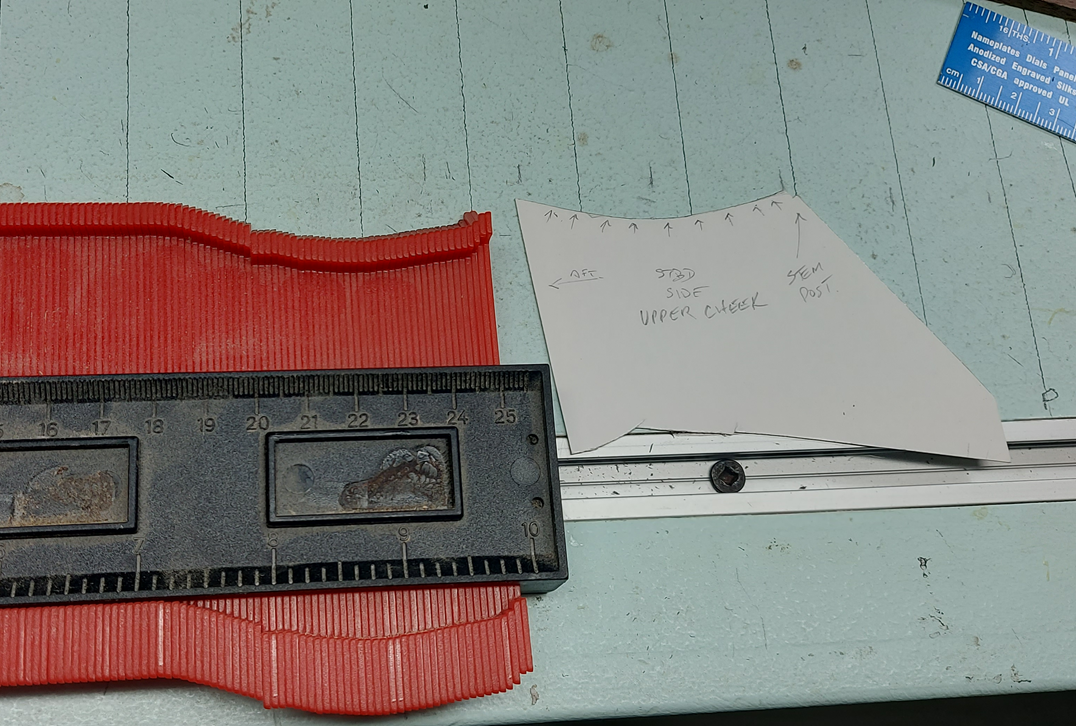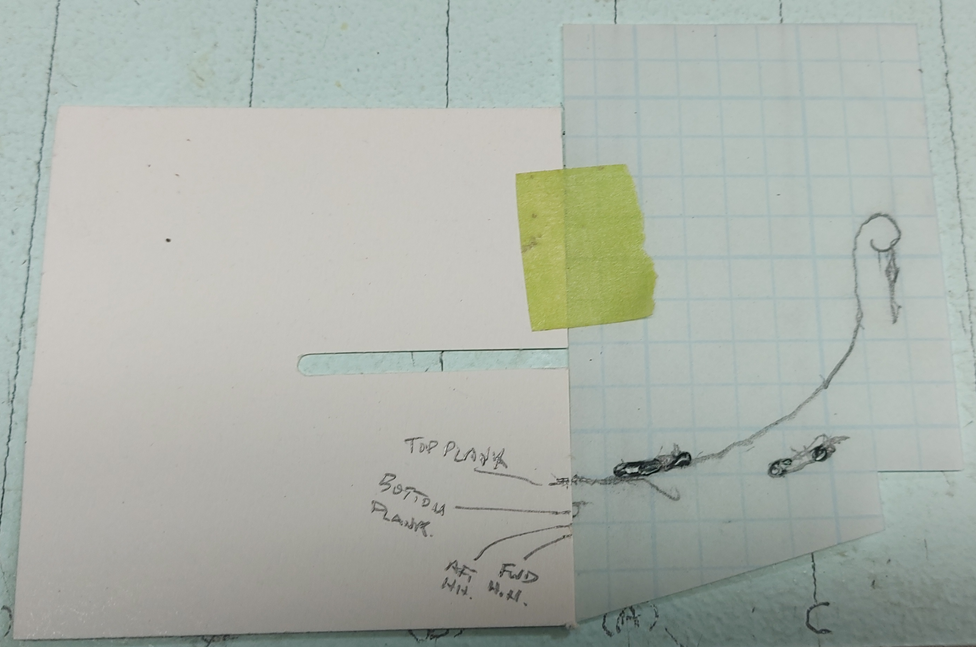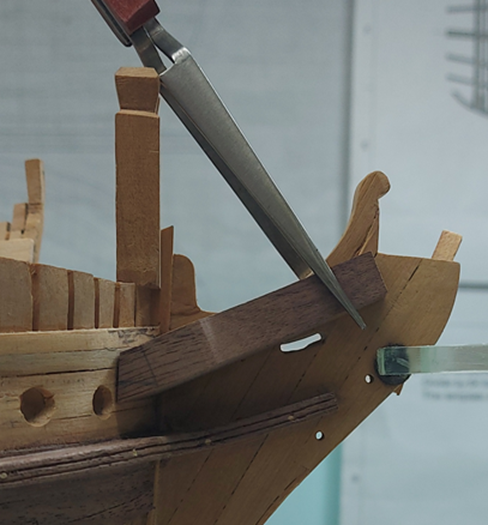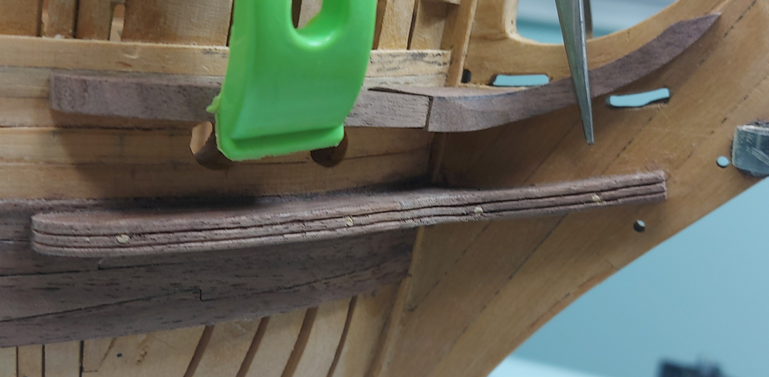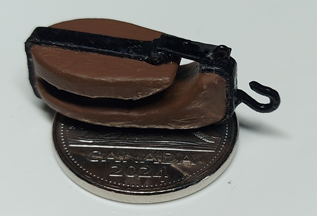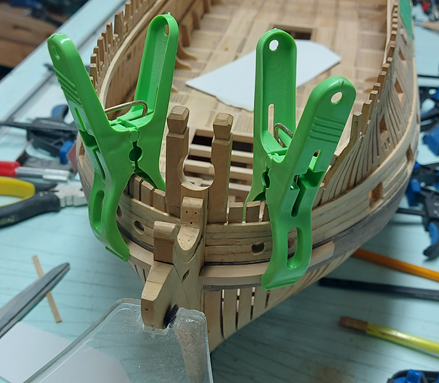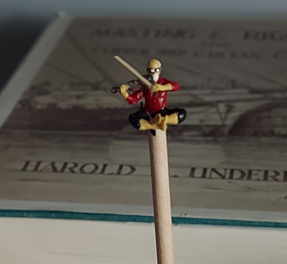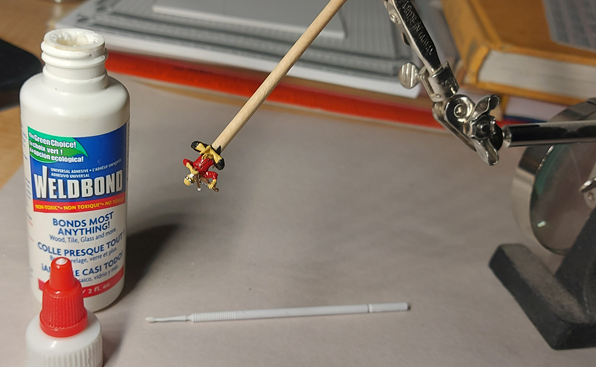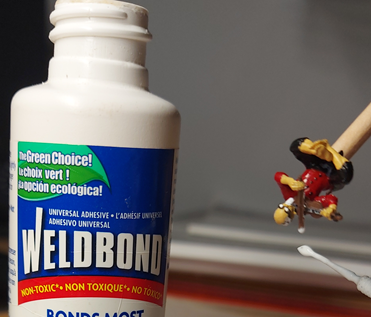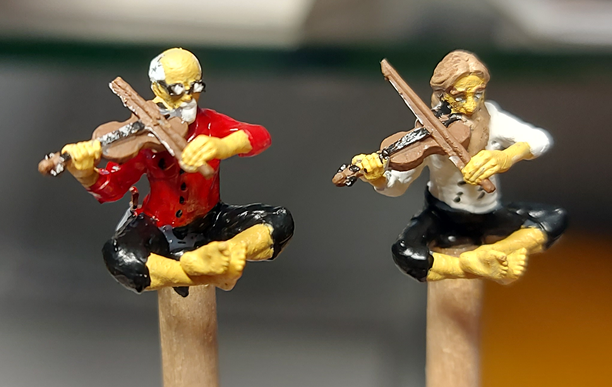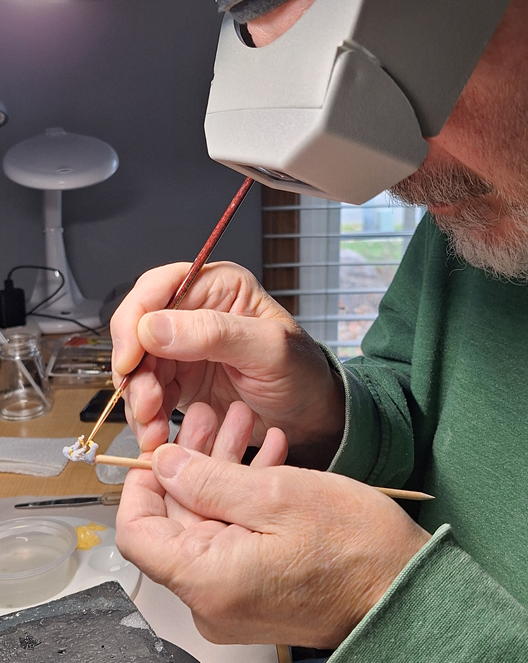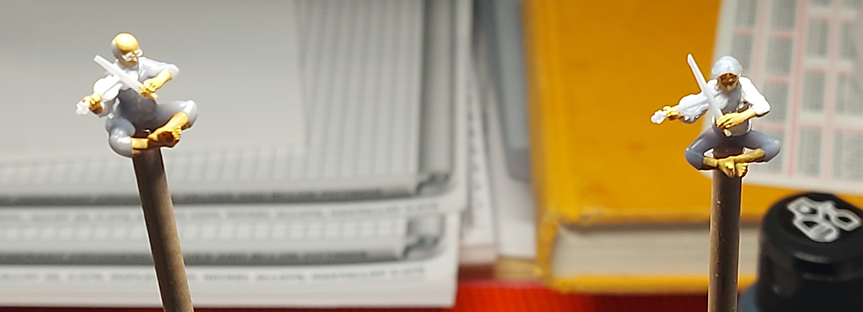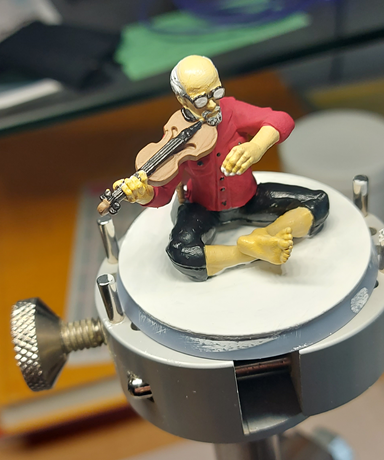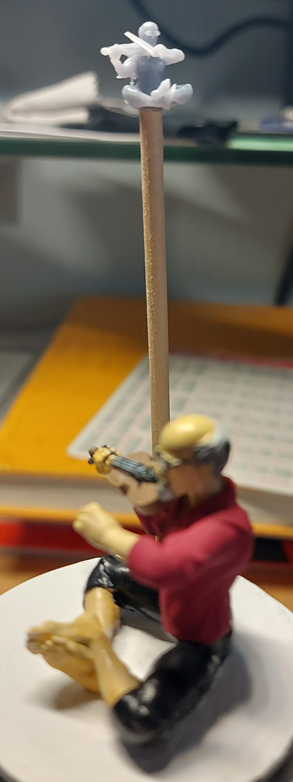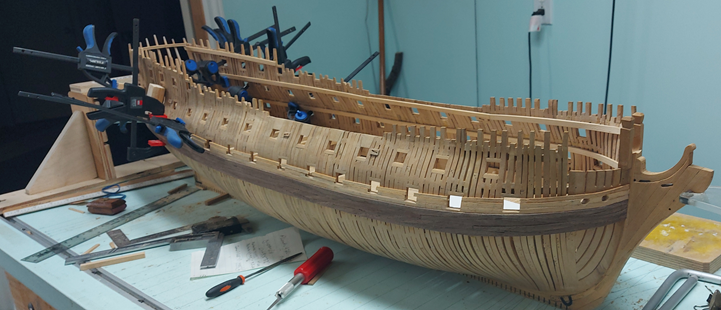-
Posts
2,859 -
Joined
-
Last visited
Content Type
Profiles
Forums
Gallery
Events
Everything posted by AON
-
I had been working on the lower cheeks and have since started the upper cheeks. I began by making a card template of the hull using my profile gauge. Then I traced the stem works to fit the upper cheek between the gammoning slots. The lower cheek was made in two pieces, glued and pinned with wooden dowels requiring #57 drill bit holes. The upper cheek will be in three pieces of which I have two pieces roughed. The piece against the stem works is longer than needed. I will make the mating piece longer and trim the two to fit. Tomorrow I will make up the hawse bolster and backing plate pieces to help with spacing and alignment of the upper cheek pieces.
-
forgot to mention is was very cold this morning up here.
- 1,126 replies
-
They can easily be cleaned up with a very narrow chisel, if you have one. If not, possibly I can bring you one 😃
- 1,126 replies
-
My first attempt at the lower cheeks was not a complete disappointment. Both lower cheeks were aligned with each other and a nice gentle slope on the forward arm. Made in two pieces... the joint wasn't quite good enough, even for me. 😁 My second attempt should be the keeper. Presently busy making one Christmas and one birthday present in the shop, on the sly, in between work on the cheeks. December is a busy month.
-

Golden Hind by Rock_From_Korea - 1:48
AON replied to Rock_From_Korea's topic in - Build logs for subjects built 1501 - 1750
The small details make all the difference. They both look wonderful! -
With a couple figures done and the three rows of 4" planking completed, it is time for a change before I go back to yet more planking. I decided to complete the assembly of my 3D printed viol/vyol block. The strapping is blackened card stock. The hook is copper wire that has been twisted and filed to shape. The completed block is placed on a 5cent piece for scale. I then started on the outer lower halves of the lower cheeks. Used some scrap pieces (of which I have plenty) for this first attempt. They fit up quite nicely. Still require shaping and rounding the edges. I'll need to make myself a scraper. Now to attempt the forward halves of the lower cheek assembly.
-
Not sure what I am supposed to see. I did sleep in so maybe I'll need a moment. A moment later.. I see it, the ring on the too of the lower capstan. Looking good!
- 1,126 replies
-
It is wonderful to have you back. I hope you are doing well yourself. Looking forward to seeing more of your work!
-
Well there is always something to force you to change plans Yesterday, I started shaping the extension on the bow but didn't like where it was going, so I cut off the glue and started over. Last night it looked much better and I felt I wouldn't need to shape it. Just let it cure and then apply paint. This morning I got up, took a look at it and was quite pleased. Started working on something else and when I was done that I looked up and the whole extension from the strings out was gone! Couldn't find it anywhere. I must have knocked it. I cut the complete bow off at the hand and replaced the full length with a piece of bamboo. I'll paint that later today and pack it away.
-
You said: "This is going much easier then I thought it would". I always regret saying those words. Hope you don't! 😉
- 1,126 replies
-
Worked on repairing the broken fiddle bow today. As the broken part is missing I brought up my bow stretcher from the shop. I keep it next to my sky hooks. 😁 All joking aside.... I use WeldBond to rebuild the missing part. I suspend the bow vertically downwards so I have gravity working for me. I applied a drop to the broken end and let it dry for about 20 minutes before applying another drop. It slowly grows in length 1mm at a time! Once I have it long enough, I have to let it cure (dry and harden) for 24 hours. Tomorrow I with break out the sanding board and gently file it to shape. Finally, it will get painted and after another couple days (to let the paint dry thoroughly) it will get a matt spray sealing coat.
-
Use a extra good fine brush. A dot of paint on the tip. Spread a little on. Wet the tip of the brush and dab it on a paper towel then brush what you applied to smooth it out. Let it dry before touchups. I mounted the little fellas on a dowel using a drop from a hot glue gun and use the stick or a finger from my one hand to steady my other hand on. Don't forget magnification and good lighting.
-
On August 21st this year, I had posted a couple 1:64 scale 3D figures that were made for my build. Today I decided to paint one large figure to "get the hang of it". A practice run if you will. This figure is a larger version... of me with my fiddle. I had broken the bow off so had made a new replacement (wooden bow and hair from my shop brush). The bow was removed for painting. Acrylic paints and brushes. Letting it dry for a day or two before I give it a protective spray matt sealer coating. I was going to do my plaid shirt but that is too difficult to replicate. I was also going to add a small tuft of hair on my dome but, what the heck, I'm certain I'll get there one day soon! 😉 Now having "mastered" that I feel I've learnt nothing when I put the 1:64 scale mini me next to it. I'll give him a go tomorrow.
-

Need small repair done on jibboom of Le Superbe model
AON replied to Mr. Matt's topic in Masting, rigging and sails
tmj's suggested repair above is the quickest and easiest! Once you wrap it with the cling wrap you might also apply a splint to hold the assembly in place using something like toothpicks and elastic bands or string if it is still on the model with rigging. Other option is to remove the pieces, drill both broken ends and insert a metal pin and epoxy them. The metal pin gives some additional strength. Alignment on a break has always been a problem for me. Another option is to remove the pieces, cut a slot through the two broken ends and insert a biscuit (wafer of wood) and epoxy it all back together. This is a little easier to align. I read you reached out to local clubs. Does this include the Model Shipwrights of Western NY located in Rochester? I might be able to help you contact them. PM me if you'd like some help. Alan O'Neill Model Shipwrights of Niagara (MSON) -
Working on the installation of some exterior hull planking above the main wales. Two rows of "thick stuff upon the wales". First row 6-1/2" thick, second row 5-1/2 inches thick. Now working on 3 rows of 4 inch thick planking above that. One row installed. Thought it best to get this on while I can still use my 4" bar clamps through the gunports. If I attempt this after the main deck is installed I'd be in trouble. Turns out it was a lucky thing I had to tear that deck out earlier.
-
Having done some for the MSON, I feel for you and the massive quantity of videos you've committed to indexing, but rest assured that everyone using them will appreciate the work. I hope you haven't committed to a deadline!
- 1,126 replies
-
I would think a video log is better than any memory to allow you to physically see how you did something months or years ago!
- 1,126 replies
-

Leon by Doug McKenzie - 1:300 - BOTTLE
AON replied to Doug McKenzie's topic in - Build logs for subjects built 1851 - 1900
Good evening Doug. I thought I'd watch you, learn and possibly try something easy .... but it looks like there might not be anything easy about ships in a bottle! I might try a submerged submarine! 😃 You must have one very steady hand. Alan -
Odd... 9" versus 10"... to save weight. They would start with 10" and spend extra time cutting away 1"!?. The half span is where the strength is needed, not at the ends.... unless it had to do with wood rot.
- 1,126 replies
About us
Modelshipworld - Advancing Ship Modeling through Research
SSL Secured
Your security is important for us so this Website is SSL-Secured
NRG Mailing Address
Nautical Research Guild
237 South Lincoln Street
Westmont IL, 60559-1917
Model Ship World ® and the MSW logo are Registered Trademarks, and belong to the Nautical Research Guild (United States Patent and Trademark Office: No. 6,929,264 & No. 6,929,274, registered Dec. 20, 2022)
Helpful Links
About the NRG
If you enjoy building ship models that are historically accurate as well as beautiful, then The Nautical Research Guild (NRG) is just right for you.
The Guild is a non-profit educational organization whose mission is to “Advance Ship Modeling Through Research”. We provide support to our members in their efforts to raise the quality of their model ships.
The Nautical Research Guild has published our world-renowned quarterly magazine, The Nautical Research Journal, since 1955. The pages of the Journal are full of articles by accomplished ship modelers who show you how they create those exquisite details on their models, and by maritime historians who show you the correct details to build. The Journal is available in both print and digital editions. Go to the NRG web site (www.thenrg.org) to download a complimentary digital copy of the Journal. The NRG also publishes plan sets, books and compilations of back issues of the Journal and the former Ships in Scale and Model Ship Builder magazines.


